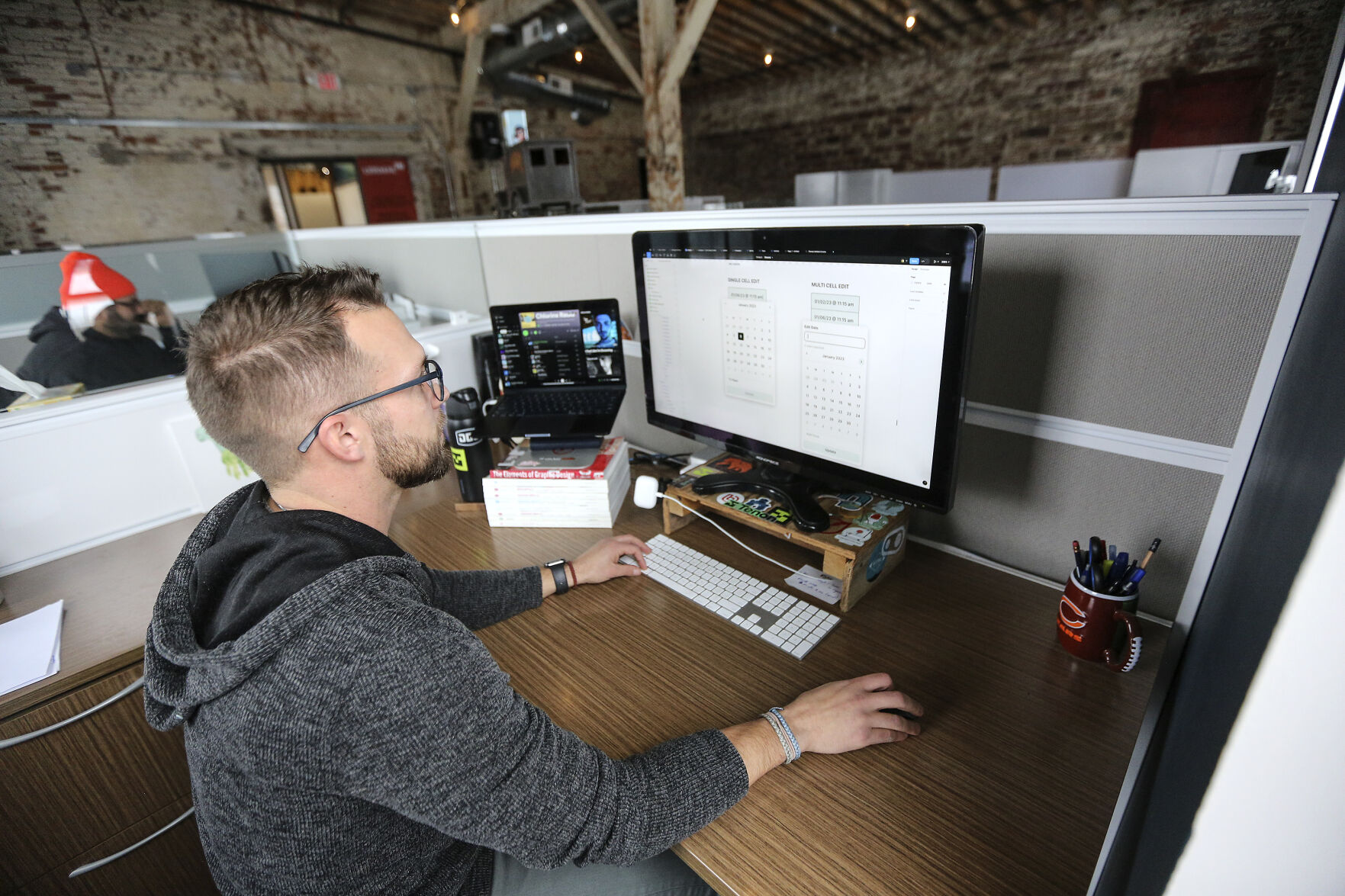Eric Peters’ nearest co-worker lives a few hundred miles away.
Peters, of Dubuque, is a senior product designer for Tenon, a remote startup promoting enterprise solutions for marketing teams nationwide. And just like its clients, the company’s employees similarly are spread out.
“I’m in Dubuque, but we also have a guy out in San Diego (Calif.) and then the majority of the team is spread out closer to the Indianapolis (Ind.) area,” Peters explained. “I try to head over there once every six weeks, but most of the time I’m here.”
Peters is one of thousands of local residents whose job involves full- or part-time remote work, and he splits his time between his home office and the coworking space at The Innovation Lab’s Dubuque location.
He also is one of the 42% of U.S. workers whose job involves at last some level of remote or hybrid work, including the 13% of workers whose work is completely remote. It’s a model that exploded during the COVID-19 pandemic and one area experts expect is here to stay.
“I think there was this anticipation after the COVID period stabilized that remote work and hybrid work situations would fall to the wayside, but that really does not appear to be the case,” said Nic Hockenberry, director of workforce programming at Greater Dubuque Development Corp.
Remote work refers to work that can be completed from any location without the worker needing to be physically present at the workplace. Hybrid work refers to workers who work in person sometimes and remotely others.
Most U.S. employees got their first taste of remote work at the pandemic’s onset when many workers were sent home to minimize exposure to the coronavirus.
Demand for online video and communication platforms such as Zoom and Microsoft Teams skyrocketed, and employers and employees alike had to adjust to team members working from swiftly cobbled-together home offices.
But with time, experiences and expectations evened out.
“It’s been somewhat of a learning curve for both the employers and the employees,” Hockenberry said. “But now it seems people have figured out what remote work really looks like, … and we’re seeing it here across different industries.”
Dupaco Community Credit Union switched much of its workforce to remote operations when the pandemic began before having staff trickle back in as public health guidance allowed. Still, roughly half of Dupaco’s nearly 700 employees currently work a hybrid schedule.
Most of those employees still spend the majority of their time in their office, said Katie McClain, Dupaco’s vice president of human resources, but they also will spend one or two days a week working remotely.
“As we’ve continued to grow, this really seems like the future of work,” McClain said. “It’s really allowed us to think not only about what our members need, but also our employees.”
Generally speaking, hybrid and remote work models are most popular with younger employees — particularly those age 24 to 35 — who cite increased flexibility as the model’s top benefit, according to a Forbes Advisor poll.
The model also can offer certain benefits to businesses. Some companies might have employees work fully remote and only gather in person every few months, for example, negating the need for a large, permanent office.
A number of companies reserve meeting rooms at The Innovation Lab for such meetings, Director Eric Dregne said. There are five such sites across northeast Iowa, each equipped with low-cost coworking and meeting spaces.
“Companies are seeing that they may not need that stereotypically big office anymore,” Dregne said. “Instead, they can bring the remote workers somewhere together once every few months when they need that in-person component.”
Individual workers such as Peters also use the lab’s coworking space to utilize its extra resources, meet other working professionals or add a degree of separation between their home and work lives.
“It’s great because there’s a space you can always go to work but that you’re not required to go to,” Peters said. “… And because I work for a remote team, it’s been nice to have that social aspect, even if it’s just a quick chat between desks.”
The computer and information technology sector was the top industry for remote work in 2023, according to Forbes, followed by marketing, accounting and finance.
The traditional workplace is far from obsolete in those industries and others, however. The majority of U.S. workers still hold positions exclusively filled in-person.
For some jobs — such as a grocery store clerk or a plumber — remote work isn’t an option. Other people are more reticent to leave behind the networking and mentorship opportunities that come with a physical workplace.
“There is a prevailing wisdom and common sense to meeting in person to make sure everyone is on the same page,” Hockenberry said. “That’s why a lot of touch points or in-person requirements of remote or hybrid jobs typically have to do with moments of collaboration.”





